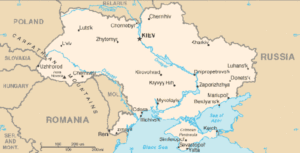 The history of the Jews in Ukraine goes back over a thousand years. Jewish communities have existed in the territory of Ukraine from the time of Kievan Rus when Jewish refugees from Byzantium, Persia, and Mesopotamia, fleeing persecution by Christians, settled along the banks of the River Dnieper in eastern and southern Ukraine. Under the rule of the Khazar Empire, Jews were able to freely practice their religion, and over time, many Jews integrated into Khazar society. In Kyiv, a tributary of the empire, where there was a large Jewish quarter and one of the city’s three gates was called the “Jew’s Gate.”
The history of the Jews in Ukraine goes back over a thousand years. Jewish communities have existed in the territory of Ukraine from the time of Kievan Rus when Jewish refugees from Byzantium, Persia, and Mesopotamia, fleeing persecution by Christians, settled along the banks of the River Dnieper in eastern and southern Ukraine. Under the rule of the Khazar Empire, Jews were able to freely practice their religion, and over time, many Jews integrated into Khazar society. In Kyiv, a tributary of the empire, where there was a large Jewish quarter and one of the city’s three gates was called the “Jew’s Gate.”
Right-bank Ukraine, an area west of the Dnieper River was then subject to Lithuania and saw the arrival of Jews from Western Europe. The Jewish presence increased with the absorption of Lithuania by the Polish crown into the Polish-Lithuania Commonwealth in 1569, as Poland’s economic influence afforded Jewish settlers a variety of economic opportunities. Jews were influential in a variety of enterprises and served as liaisons between Ukraine and the Ottoman Empire. Ukraine soon became a center of Jewish life in Poland-Lithuania, and Jews were the largest and most important ethnic minority in Ukraine. However, despite their successes, the Ukrainian Jewish community found itself faced with hardships.
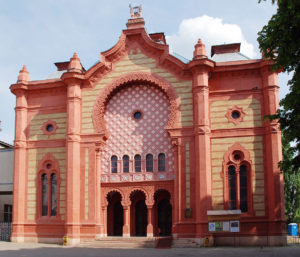 Growing anti-Semitism among the Ukrainian Cossacks exploded in 1648 with the Cossack Uprising against the Jews. The Cossacks began massacring thousands of Jews in the Chmielnicki Massacre from 1648 to 1649. Over 20,000 Jews – about half of the region’s population – were brutally murdered, and many fled the country. Those who survived were subject to numerous “repeat” massacres, and under Russian rule, anti-Semitism in Ukraine only worsened. Yet, Jewish life in Ukraine continued on, and Jews continued to emigrate to the region and play a large role in economic matters.
Growing anti-Semitism among the Ukrainian Cossacks exploded in 1648 with the Cossack Uprising against the Jews. The Cossacks began massacring thousands of Jews in the Chmielnicki Massacre from 1648 to 1649. Over 20,000 Jews – about half of the region’s population – were brutally murdered, and many fled the country. Those who survived were subject to numerous “repeat” massacres, and under Russian rule, anti-Semitism in Ukraine only worsened. Yet, Jewish life in Ukraine continued on, and Jews continued to emigrate to the region and play a large role in economic matters.
In the late eighteenth century, with the repeated division of Poland in 1772, 1793, and 1795 and Ukraine’s absorption by Russia, the situation changed starkly for the Jews. Russia, which had forbidden Jews the right to reside in its territory, suddenly found itself in charge of the largest Jewish population in the world. The czarist government thus established the boundaries of a “Pale of Settlement” within which Jews were forced to settle, an area coinciding approximately with the regions taken from Poland (Lithuania, Belarus, Ukraine west to the Dnieper, the kingdom of Poland); added to these were virgin lands in the New Russia (Kherson, Nikolayev, Odessa, Crimea), as well as the left bank of the Dnieper (Poltava, Kremenchug, Ekaterinoslav – renamed Dnepropetrovsk).
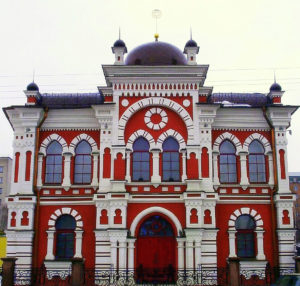 The Russian Empire’s repressive policies persisted throughout the nineteenth century. In 1827, Jews were officially expelled from Kiev. After a period of liberal reforms under Alexander II, oppression of the Jews picked up again with Alexander III, during whose reign a number of pogroms took place against the Jewish population, driving the latter to emigrate in ever large numbers to Europe and the United States. At the end of the First World War, 1917-1921, revolution and civil war tore through Ukraine. Nationalist gangs led by Simon Petliura perpetrated atrocious pogroms, massacring 100000 Jews across the country in cities such as Zhitomir, Proskurov, Rovno, Belaya Tserkov, Kiev, and Vinnitsa. The Soviet powers, in contrast, abolished the “Pale of Settlement” and other restrictions against the Jewish community but simultaneously began antireligious campaign that let to the closure of many synagogues.
The Russian Empire’s repressive policies persisted throughout the nineteenth century. In 1827, Jews were officially expelled from Kiev. After a period of liberal reforms under Alexander II, oppression of the Jews picked up again with Alexander III, during whose reign a number of pogroms took place against the Jewish population, driving the latter to emigrate in ever large numbers to Europe and the United States. At the end of the First World War, 1917-1921, revolution and civil war tore through Ukraine. Nationalist gangs led by Simon Petliura perpetrated atrocious pogroms, massacring 100000 Jews across the country in cities such as Zhitomir, Proskurov, Rovno, Belaya Tserkov, Kiev, and Vinnitsa. The Soviet powers, in contrast, abolished the “Pale of Settlement” and other restrictions against the Jewish community but simultaneously began antireligious campaign that let to the closure of many synagogues.
Prior to the outbreak of the war, the census of 1939 reported 1,532,827 Jews in the Ukraine. At the outbreak of World War II, western Ukraine was taken under Nazi control. Those Jews who lived in those regions were placed into ghettos and deported to death camps. Mass killings in Ukraine began almost immediately upon the widespread Nazi invasion of the country during Operation Barbarossa in 1941. The German army was accompanied by Einsatzgruppen units, which rounded up Jews across the country and brutally murdered them. It is important to note that throughout the Holocaust, Ukrainians played an active and supporting role in collaborating with the Nazis and participating in the genocide of Jews in Ukraine.
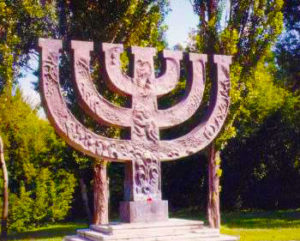 The most notorious massacre of Jews in Ukraine during the Holocaust occurred at the Babi Yar ravine outside Kyiv, where 33,771 Jews were killed in a single operation from September 29 to 30 in 1941. It was carried out by a mixture of SS, SD and Security Police, assisted by the Ukrainian Auxiliary Police. The Jews of Kyiv gathered by the cemetery, expecting to be loaded onto trains. All were driven down a corridor of soldiers, in groups of ten, and then shot. In the evening, the Germans undermined the wall of the ravine and buried the people under the thick layers of earth. Wounded victims were buried alive in the ravine along with the rest of the bodies. The money, valuables, underwear and clothing of the murdered victims were turned over to the local ethnic Germans and to the Nazi administration of the city.
The most notorious massacre of Jews in Ukraine during the Holocaust occurred at the Babi Yar ravine outside Kyiv, where 33,771 Jews were killed in a single operation from September 29 to 30 in 1941. It was carried out by a mixture of SS, SD and Security Police, assisted by the Ukrainian Auxiliary Police. The Jews of Kyiv gathered by the cemetery, expecting to be loaded onto trains. All were driven down a corridor of soldiers, in groups of ten, and then shot. In the evening, the Germans undermined the wall of the ravine and buried the people under the thick layers of earth. Wounded victims were buried alive in the ravine along with the rest of the bodies. The money, valuables, underwear and clothing of the murdered victims were turned over to the local ethnic Germans and to the Nazi administration of the city.
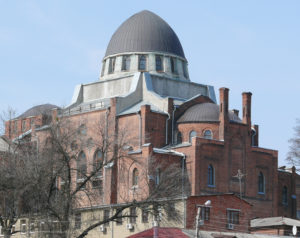 Ghettos began to be established throughout the country in 1942 and the Janowska concentration camp in L’viv became one of the more notorious transit camps, where thousands of Jews were deported to their deaths. By the time Ukraine was liberated from Nazi control, approximately 1.5 million Ukrainian Jews had been murdered; over half of the pre-war Jewish population. After World War II, under Nikita Khrushchev’s rule over Ukraine, Ukrainian Jews who fled to Soviet Asia during the occupation slowly returned to reclaim their homes, possessions and jobs. The Ukrainians who remained in the communities were hostile to the returning Jews. The government, once again, refused to interfere in the conflicts between the Russians and the Jews. As a result, anti-Semitic sentiments surfaced everywhere.
Ghettos began to be established throughout the country in 1942 and the Janowska concentration camp in L’viv became one of the more notorious transit camps, where thousands of Jews were deported to their deaths. By the time Ukraine was liberated from Nazi control, approximately 1.5 million Ukrainian Jews had been murdered; over half of the pre-war Jewish population. After World War II, under Nikita Khrushchev’s rule over Ukraine, Ukrainian Jews who fled to Soviet Asia during the occupation slowly returned to reclaim their homes, possessions and jobs. The Ukrainians who remained in the communities were hostile to the returning Jews. The government, once again, refused to interfere in the conflicts between the Russians and the Jews. As a result, anti-Semitic sentiments surfaced everywhere.
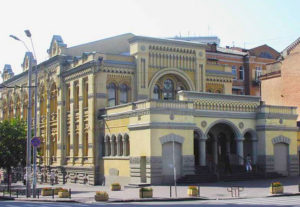 It was not until perestroika in 1985 and Ukraine’s independence in 1991 that a Jewish cultural renaissance began. In 1989, a Soviet census counted 487,000 Jews living in Ukraine. The Kiev Jewish Gymnasium Orach Chaim, opened in 1990 and licensed by the State Educational Authorities, was the first Jewish secondary school in Ukraine after World War II.
It was not until perestroika in 1985 and Ukraine’s independence in 1991 that a Jewish cultural renaissance began. In 1989, a Soviet census counted 487,000 Jews living in Ukraine. The Kiev Jewish Gymnasium Orach Chaim, opened in 1990 and licensed by the State Educational Authorities, was the first Jewish secondary school in Ukraine after World War II.
Since the collapse of the Soviet Union, 80% of the Jewish community has emigrated. Today, the community has formed 40 religious societies, and built 24 synagogues. Jewish organizations created within Ukraine have been raising funds for relief within the Jewish community, furthering Jewish education, and building Holocaust memorials. The city now has three new congregations. In late 2004, a new Jewish community complex opened in Zaparozhye. In April 2005, the historic Egie Kapai synagogue was rededicated. In October 2012, a multifunctional Menorah centre was established in Dnipro. However, the outbreak of violence in the 2014 Ukrainian Revolution saw many Ukrainian Jews leave for Israel and the precarious economic situation of the Jewish community has been a decisive factor in the aliya of Ukrainian Jews.
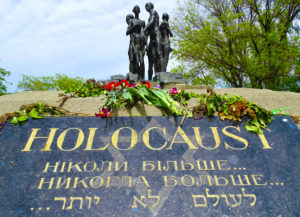 In 2016, Ukraine was home to between 56,000 and 140,000 Jews. The majority of Ukrainian Jews live in Kyiv, but there are also large Jewish populations in Dnipro, Kharkiv and Odessa. In 2016, Vlodymir Groysman became the first Jew to ever serve as Ukrainian Prime Minister and in commemoration of the 75th anniversary of the Babi Yar massacre, President Petro Poroshenko and Kiev mayor Vitali Klitschko announced plans to create a memorial, which would be the first Holocaust memorial site in Ukraine.
In 2016, Ukraine was home to between 56,000 and 140,000 Jews. The majority of Ukrainian Jews live in Kyiv, but there are also large Jewish populations in Dnipro, Kharkiv and Odessa. In 2016, Vlodymir Groysman became the first Jew to ever serve as Ukrainian Prime Minister and in commemoration of the 75th anniversary of the Babi Yar massacre, President Petro Poroshenko and Kiev mayor Vitali Klitschko announced plans to create a memorial, which would be the first Holocaust memorial site in Ukraine.